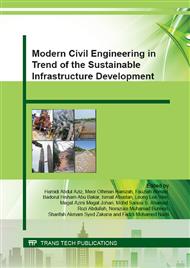p.295
p.303
p.309
p.315
p.321
p.327
p.333
p.339
p.345
Effects of Calcium Carbonate and Treated Palm Oil Fly Ash on the Rheological Properties of Asphalt Mastic
Abstract:
In sustainable asphalt pavement construction, the proper selection of materials can be a challenging task. This paper focuses on a newly developed asphalt modifier named calcium carbonate (CaCO3) combined with Treated Palm Oil Fly Ash (TPOFA) to improve the properties of asphalt mastic. The rheological properties of mastic in terms of penetration, softening point, rotational viscosity and Superpave rutting factor using 60/70 asphalt binder blended with 5, 10, 15, 20 % of CaCO3+TPOFA were calculated to evaluate asphalt binder properties subjected to different aging conditions. The rotational viscometer (RV) was used to evaluate the properties of mastic at test temperatures from 120°C to 170°C. The dynamic shear rheometer (DSR) was used in temperature sweep test from 46°C to 82°C at 6°C increments at 10 rad/sec frequency to measure the G*, δ and Superpave rutting factor G*/sinδ. A one-way ANOVA statistical analysis was used to analyze the results .The test results showed that all asphalt mastic exhibited higher viscosity compared to the base binder. The addition of CaCO3 +TPOFA increased the G* but reduced the phase angle which indicated improved stiffness of asphalt mastic. Hence, incorporating CaCO3+TPOFA can potentially improve the rutting resistance of asphalt mastic.
Info:
Periodical:
Pages:
321-326
Citation:
Online since:
October 2015
Authors:
Keywords:
Price:
Сopyright:
© 2015 Trans Tech Publications Ltd. All Rights Reserved
Share:
Citation:


